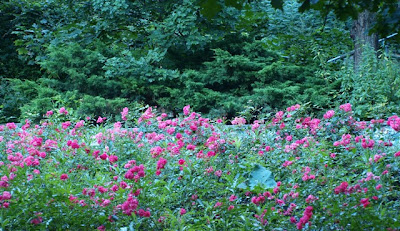Parks in the East (of Berlin)
I’m sorry if this has become a somewhat personal journey, dissecting the charm of parks and gardens as I travel willy nilly through European capitals: post-modern Will Self at Kew, begrudging respect for municipality in Prague and now post-Cold-War contradictions in Berlin.
Here in what used to be East Berlin I’m more than likely to fall into a pit of ignorance and superficiality, all dug by myself. Still, before I visit the city’s botanic garden tomorrow – the Botanischer Garten und Botanisches Museum Berlin-Dahlem – a few words on its other parks (yes a botanic garden is a park, albeit with something important extra).
The ones I’ve visited can be read in many ways. Usually there is an historic reading from a century or so ago, a Nazi or World War II reading, a Cold War rendering and finally the unification. Presumably the whole city can be read this way, and more.
The park near where we are staying in Belforter Strasse has a lovely hummock covered in wildflowers at one end and two cylindrical towers at the other. One tower is tall and thin, the other shorter and stout. The towers are sometimes called Thin and Thick Hermann.
The hummock I suspect is an old World War II bunker, or perhaps part of a large subterranean water tank. There are art studios now opening through roller doors into its side, but covering the flanks, a charming walk through colourful flowers. Thin and Thick Hermann are watertowers built in the mid to late nineteenth century. People now live in at least the Thick one at least. During the Nazi period it seems they were used to drown dissidents or the disliked. When I visited yesterday early in the morning it was quiet but by late in the day there are locals walking and sitting, looking and talking.
Meauerpark, a mile or so away flanks the remains of the Berlin Wall. This is not one of the popular tourist destinations and the park is young and bleak to my eyes. Unlike the wall beside Mühlenstrasse, now an artwork on the ex-East side, this is more a work in progress with a spray can still sitting nearby from a recent contribution. Like all the parks in this area, though, later in the day I'd expect the playgrounds to be full of families, and open spaces of dogs and dog-walkers.
The final park I want to mention was previously a cemetery, and there seems to be an ‘active’ burial area surrounding it. Leisepark is on Heinrich-Roller Strasse, in Prenzlauer Berg (our district for a few days) and it still has a few grave stones from when it was the St Marien-St Nicolai Cemetery. There are signs about trees, birds, foxes and…grave stones. The remains of the graves are intermingled with play equipment and seats. Odd but in the context of this district, this city and this post, apt.
Images: the top picture is from the Rose Garden at Volkspark Friedrichshain, and all the pictures have that washed out look that photos get when taken too early in the morning. I'll finish with just a couple of examples of the creative wall art around Berlin (some is more edgy but perhaps not as suitable for a family blog such as this one...)











Comments